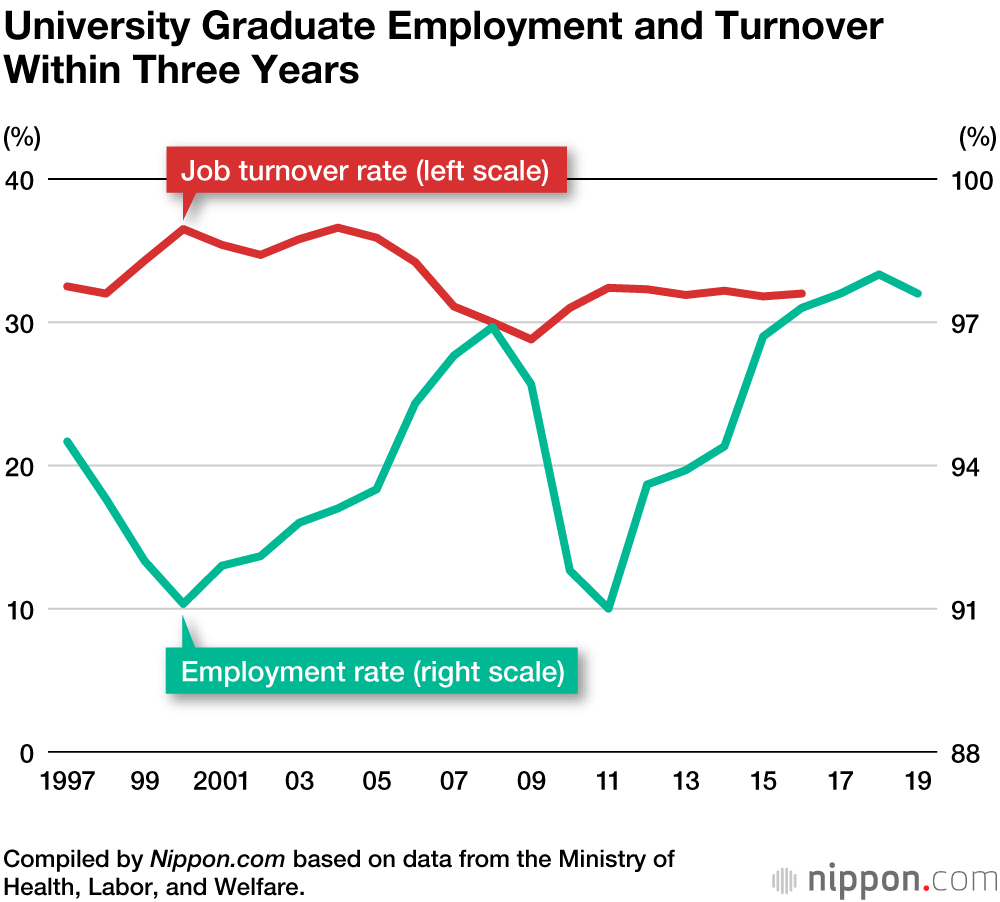Introduction
Japan’s low turnover rate has long been a subject of intense academic interest. Employees with a higher job attachment acquire professional skills over time, while high turnover rates lead to slower growth in labor productivity. However, at the moment, the increase in turnover rate is observed in almost all areas and industries in Japan, which may lead to higher recruitment and training costs, as well as lower work efficiency. Employee trust and turnover intention are crucial factors in this regard. As a rule, it is the employee trust that is connected with professional development and productive performance. The study explores how employee trust in their employer can affect their turnover intention in Japanese companies.
Main body
This research examines the employment system of Fujitsu, a major Japanese electronics and IT product manufacturer and a global enterprise. The main objectives of the study are to investigate the relationship between the employment system of Fujitsu and its employee trust; employment security and Fujitsu’s employee trust; employment relationship and Fujitsu’s employee trust; and Fujitsu’s employee trust and their turnover intention. The research questions based on these objectives are related to the exploration of employee turnover in Japan as well as the impact of employee trust on the Japanese performance system and turnover intentions. It also seeks to provide the most appropriate recommendations for the improvement of the Japanese employment system.
Employment System in Japan
The Japanese employment system combined traditional national features with the characteristics of European and American employment modes. Okochi et al. (1974) suggested the idea of lifetime employment, according to which companies would be able to hire graduate students and provide them with long-term employment. After a period of recovery from World War II, Japanese enterprises began to gradually implement this principle regularly. To be flexible, companies have created a dichotomic employment system that includes formal long-term employees and informal temporary employees. Due to the economic downturn in the 1990s, as well as the transformation of the life priorities of young people searching for better job opportunities, companies began to reform the existing system. Along with the increase in the turnover rate, the number of informal, hourly, and free employees also grew significantly.
Turnover Among Recent Graduates
The younger generation is more inclined to compete and look for better jobs, and therefore the turnover rate among them has remained consistently high in recent years. Moreover, these employees became the most attractive to employers. Companies started to invent ways to reduce the number of formal workers who enjoy the right to life-long employment, for example, by reassigning employees to less attractive positions in branches and subsidiaries. In addition, Japanese enterprises began permitting middle-aged and older employees with higher wages to retire in advance. These measures resulted in a significant increase in the number of informal workers and a reduction in the number of formal workers, as well as a diversification of types of employment. Moreover, the gap between formal and informal employee positions is narrowing over time.

Employee Turnover Intention
Turnover intention means the tendency of workers to leave their jobs in order to discover more advantageous job opportunities (March & Simon, 1958). As a rule, it is caused by dissatisfaction with working conditions and precedes actual turnover. Researchers note that among the factors influencing the turnover intention may be financial conditions, the complexity of work, incentive measures of enterprises, an expectation of future development, pleasure, and even gender and age. There are many theoretical models that attempt to explain and predict the phenomenon of turnover through the use of many variables and factors. For instance, March and Simon Model considers employees’ satisfaction with their jobs and their estimation of the likelihood of inter-firm mobility. At the same time, the Extended Mobley model takes into account many additional variables including enterprise, environment, and individual.
Trust is a significant concept related to staff productivity, but various researchers interpret it according to highly different approaches. At the same time, a significant number of definitions include the concepts of risk and vulnerability (Stahl et.al, 2006).
For example, Mayer et al. (1995) define trust as the willingness of a party to be vulnerable to the actions of another party based on the expectation that the other will perform a particular action important to the trustor. In addition, some researchers distinguish between affective trust and cognitive trust, where the former is a consequence of subjective perceptions and impressions and the latter is based on rational judgment (McAllister, 1995). Accordingly, this study examines both the emotional and cognitive employee trust in relation to employment security and turnover intention.
Employment security is related to the employer’s guarantee not to fire an employee for subjective reasons, as well as not to threaten to fire him/her in the course of management activities (McCallum, 1994). It is related to income, social benefits and professional opportunities for the employee. Japanese companies have ensured high employment security through the implementation of the principle of life-long employment. Employees who are in constant fear of being fired tend to have the worst performance and prefer to change job (Williams & Beck, 2018).
Researchers consider employment security from external and internal perspectives. The external one is related to labor law and regulatory guarantees, and the internal one is associated with human resource management. The latter is the focus of this study.
Employees, employers, the market, the state and the contract are involved in an employment relationship. An employee is considered an economic person interested in maximizing income and leisure time (Kaufman, 1999). At the same time, employees are regarded as the production factor used by the employer to increase profits, and the employer is the buyer of the employee’s workforce. The market is a platform for interaction between employees and employers, as well as for search for appropriate employment opportunities (Zhang et al., 2014).
The state is an important participant in an employment relationship, as it carries out legislative activities and affects the economic situation. The contract is a mutual agreement between the employer and the employee, establishing specific rights and obligations of the parties. All elements of an employment relationship are the object of research.
Research Framework and Hypothesis
On the basis of the analysis and theoretical review of the relationships between employment recruitment system, employment security, employment relationship, employment trust and employee turnover intention, and other influencing variables, a research framework was developed, and you can see it on the slide. This study intends to test five research hypotheses based on this framework. The first hypothesis assumes that employment security will be negatively correlated with employees’ turnover intention. The employee’s confidence in the stability of their employment in the company as well as in the future of the company increases job satisfaction and consequently reduces the turnover intention. The second hypothesis is constructed on a similar principle and assumes that employment security increases the trust of Japanese employees in enterprises.

Researchers note that a clear formalization of the rights and obligations of the employee, as well as employment protection of their interests and remuneration system result in the employee’s perception of the value of the company (Hong et al., 2011). Consequently, such a high level of employment security causes the employee to consider leaving the employer as a sacrifice.
Accordingly, the hypothesis assumes that the improvement of employment security could reduce Japanese employees’ turnover intentions. The study also hypothesizes that a typical life-long employment system would be positively correlated to the employment security of Japanese workers, while an atypical one would be negatively correlated to it. The same principle applies to the last two hypotheses. It is assumed that a typical employment system in Japan could lead to a stable employment relationship, and an atypical employment system in Japan could lead to non-stable employment relationship.
This study will involve conducting unstructured interviews within the framework of interpretivist and constructivist approaches. During the interviews, central issues related to employee turnover and employee trust will be discussed with Japanese employees. The study also seeks to identify appropriate recommendations for Japanese employers that will enable them to use employee trust to motivate employees to stay in the company. There will also be a quantitative analysis of the statistics regarding turnover in Japan provided by Japanese official bodies or private entities, including the Ministry of Health, Labour and Welfare and DODA. It should also be noted that the interpretivist and constructivist paradigms imply that there is no single reason for the turnover phenomenon. Interview data will reveal some information that will improve understanding of the situation.
Conclusion
Researchers will receive permission to collect data from three identified manufacturing companies through formal letters. After obtaining permission, the researcher will select three potential respondents who should be HR managers of these companies. They will receive a consent form and an invitation letter. The interviews will be conducted face-to-face in the offices of the company. They will be recorded, and their duration is expected to be approximately 30 minutes. The research questions will be in both Japanese and English. After the interviews are transcribed, a thematic analysis will be conducted to identify key themes and patterns throughout the interviews. The identification of major themes in the data collected is expected to be a significant source of information for the researcher.
References
McCallum, R. C., McCarry, G. J., & Ronfeldt, P. (1994). Employment Security. Sydney: Federation Press.
Morris, J., Delbridge, R., & Endo, T. (2018). The Layering of Meso-Level Institutional Effects on Employment Systems in Japan: Meso-Level Institutional Effects on Japanese Employment Systems. British Journal of Industrial Relations, 56(3), 603-630. Web.
Ōkōchi, K., Karsh, B., & Levine, S. B. (1974). Workers and Employers in Japan: the Japanese Employment Relations System. Princeton, N.J.: Princeton University Press.
Sticking To It? A Look at Job Turnover Among Recent Graduates. (2019). Nippon. Web.
